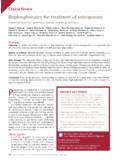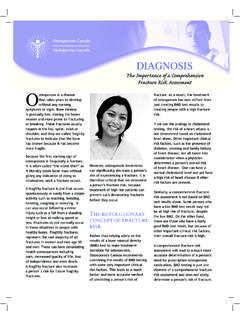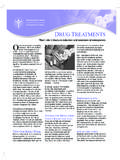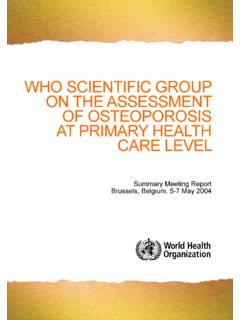Transcription of Clinical Practice Guidelines for the Diagnosis and ...
1 2010 Clinical Practice Guidelines osteoporosis : background and technical Report Page 1 Clinical Practice Guidelines for the Diagnosis and Management of osteoporosis in Canada: background and technical Report Authors: Alexandra Papaioannou MD MSc1, Suzanne Morin MD MSc2, Angela M. Cheung MD PhD3, Stephanie Atkinson PhD4, Jacques P. Brown MD5, Sidney Feldman MD6, David A. Hanley MD7, Anthony Hodsman MD8, Sophie A. Jamal MD PhD9, Robert G. Josse MD BS10, Stephanie M. Kaiser MD11, Brent Kvern MD12, Kerry Siminoski MD13, William D. Leslie MD MSc14; for the Scientific Advisory Council of osteoporosis Canada Correspondence to: A. Papaioannou St. Peter's Hospital Alexander Pavilion, Juravinski Research Centre 88 Maplewood Hamilton Ontario L8M 1W9 Phone: 905-525-9140 Extension:77715 Fax 905-318-2654 1 Professor, Department of Medicine, McMaster University 2 Associate Professor, Department of Medicine, Division of General Internal Medicine, McGill University 3 Associate Professor, Departments of Medicine and Medical Imaging, University of Toronto 4 Professor, Department of Pediatrics and Biomedical Sciences, McMaster University 5 Clinical Professor, Department of Medicine, Laval University 6 Assistant Professor, Department of Family & Community Medicine, University of Toronto 2010 Clinical Practice Guidelines osteoporosis .
2 background and technical Report Page 2 7 Professor, Departments of Medicine, Community Health Sciences, and Oncology, University of Calgary 8 Professor, Department of Medicine, University of Western Ontario 9 Associate Professor, Faculty of Medicine, University of Toronto 10 Professor, Department of Medicine, University of Toronto 11 Associate Professor, Division of Endocrinology and Metabolism, Dalhousie University 12 Associate Professor, Department of Family Medicine, University of Manitoba 13 Associate Professor, Departments of Radiology & Medicine, University of Alberta 14 Professor, Departments of Medicine and Radiology, University of Manitoba 2010 Clinical Practice Guidelines osteoporosis : background and technical Report Page 3 ABSTRACT Summary: Since the publication of the 2002 osteoporosis Canada Guidelines , there has been a paradigm shift in the prevention and treatment of osteoporosis and fractures.
3 This background document contains the technical reviews that were used to inform the development of the 2010 Clinical Practice Guidelines for the Diagnosis and Management of osteoporosis in Canada. Introduction: The focus is now on preventing fragility fractures and their negative consequences rather than treating low bone mineral density (BMD), which is viewed as only one of several risk factors for fracture. Current data suggests that many patients with fractures are not appropriately assessed or treated. Results: Systematic reviews of the literature were conducted to update our knowledge in two key areas: 1) fracture risk assessment and 2) therapies for osteoporosis . Additional topics included were identified as important for the management of osteoporosis .
4 Discussion: The management of osteoporosis should be guided by an assessment of the patient s absolute risk of osteoporosis -related fractures. Given that certain Clinical factors increase fracture risk independent of BMD, it is important to take an integrated approach and base treatment decision on the absolute risk of fracture. 2010 Clinical Practice Guidelines osteoporosis : background and technical Report Page 4 INTRODUCTION Since the publication of the 2002 osteoporosis Canada guidelines1, there has been a paradigm shift in the prevention and treatment of osteoporosis and This background document contains the evidence and technical reviews that were used to inform the development of the 2010 Clinical Practice Guidelines for the Diagnosis and Management of osteoporosis in The Guidelines summary was published in the Canadian Medical Association Journal in November of 2010 and can be viewed online at The World Health Organization (WHO)
5 Has defined osteoporosis as a systemic skeletal disease characterized by low bone mass and microarchitectural deterioration of bone tissue, with a consequent increase in bone fragility and susceptibility to fracture. Based on epidemiological data linking low bone mass with increased fracture risk, a WHO Study Group developed a bone mineral density (BMD) definition of osteoporosis as a BMD T-score or more standard deviations below peak bone Using this BMD definition, the Canadian Multicentre osteoporosis Study (CaMos) estimated the prevalence of osteoporosis in those over age 50 to be in women and in Since the publication of the last osteoporosis Canada Guidelines in 20021 there has been a paradigm shift in fracture risk assessment and treatment decisions.
6 In 2005, osteoporosis Canada adopted a system for ten-year absolute fracture risk assessment to be used in BMD Our new Guidelines focus on the Clinical impact of fragility fractures; assessment and management of women and men at high risk for fragility fracture; and integrate a new absolute risk assessment model into an overall management approach. 2010 Clinical Practice Guidelines osteoporosis : background and technical Report Page 5 Detailed background information and methods can be found in the Appendix 1, available at DEVELOPMENT OF THE Practice Guidelines The development of these Guidelines followed the Appraisal of Guidelines , Research and Evaluation (AGREE) framework (Appendix 1, Development of Guidelines and Methods).
7 7 Key stakeholders were surveyed to identify priorities for these Guidelines . Based on these priorities, systematic reviews of the literature were conducted to update our knowledge in two key areas: 1) fracture risk assessment and 2) therapies for osteoporosis . Additional topics included were identified by experts and primary care clinicians as important for the management of osteoporosis (Appendix 1, Tables A1-A5). We convened a Best Practice Guidelines Committee consisting of participants from across Canada with methodological and content expertise. Literature searches in eight electronic databases were performed: Medline, EMBASE, Cochrane Database of Systematic Reviews, Database of reviews of Effectiveness (DARE), Controlled Trials Register (CENTRAL), ACP Journal Club, Health Technology Assessment Database, and NHS Economic Evaluation Database (Appendix 1, Table A6).
8 We developed search strategies based on systematic reviews by the Cochrane Musculoskeletal Group, the PRESS (Peer Reviewed Electronic Search Strategy) checklist8 and the Cochrane Collaboration Handbook. 9 The committee identified 35 papers for assessment of fracture risk, published from January 1990 to December 2009. To maintain currency, we incorporated further relevant data up to Sept. 19, 2010 . We used the systematic review of osteoporosis therapies of MacLean and colleagues,10 who included 76 randomized trials and 24 meta-analyses, supplemented with data from 30 randomized controlled trials 2010 Clinical Practice Guidelines osteoporosis : background and technical Report Page 6 published since 2008.
9 The PRISMA flow diagram for reporting purposes was used (Appendix 1, Figures A2, A3). We abstracted all papers, graded them for quality of evidence and assigned a level of evidence using established criteria (Appendix 1, Tables A15-A23). The committee then developed and graded initial recommendations. Recommendations were graded according to the system used to grade recommendations for the 2002 guidelines1, which incorporates both level of evidence and expert consensus (Appendix 1, Table A4). Recommendations were assigned a grade of D when they were based only on committee consensus in the absence of clear supporting evidence or when evidence was weak. An expert panel, consisting of members of the osteoporosis Canada Scientific Advisory Council, members of stakeholder organizations, family physicians and experts from across Canada, met to discuss the initial recommendations (Appendix 1, Table A5).
10 The group used a modified RAND/University of California, Los Angeles Delphi method for developing consensus to ensure Clinical relevance and The Guidelines Committee and the Executive Committee of the osteoporosis Canada Scientific Advisory Council then reviewed the recommendations. The revised recommendations (presented in this report with grades in square brackets) are based on the feedback provided and were endorsed by the expert panel. The target population of these Guidelines is women and men 50 years and older and consequently the systematic reviews focused on this population. Although we acknowledge the importance of other populations with elevated risks for fracture (for 2010 Clinical Practice Guidelines osteoporosis : background and technical Report Page 7 example, individuals with chronic kidney disease), in-depth reviews of these conditions were beyond the scope of these Guidelines .






